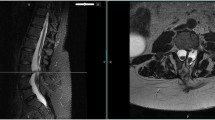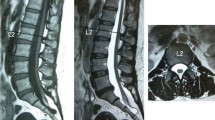Abstract
Objective
Retethering is not an unusual operation for a congenital lumbosacral dysraphic spinal lesion. The present study aimed to assess a new surgical technique for preventing retethering.
Surgical technique
After untethering the spinal cord, the pia mater or scar tissue at the caudal end of the conus medullaris is anchored to the ventral dura mater loosely using 8–0 thread, and the dura mater is closed directly. This technique is called ventral anchoring.
Results
Ventral anchoring was performed in 15 patients (aged 5 to 37 years old, average age: 12.1 years old) between 2014 and 2021. All but one patient showed improvement or stabilization of the preoperative symptoms. No complication directly related to the procedure was observed. Postoperative MRI demonstrated that the dorsal subarachnoid space was restored in 14 patients but was undetectable or absent in three patients on follow-up MRI. No patients have experienced a recurrence of the tethered cord syndrome during the follow-up period.
Conclusion
Ventral anchoring is effective for restoring the dorsal subarachnoid space after untethering the spinal cord. This preliminary study suggested that ventral anchoring has the potential to prevent the postoperative radiographic recurrence of tethered spinal cord in patients with a congenital lumbosacral dysraphic spinal lesion.






Similar content being viewed by others
Data availability
All figures and tables were prepared for the paper and were not published before.
References
Dias MS, Wang M, Rizk EB, Bowman R, Partington MD, Blount JP, Rocque BG, Hopson B, Ettinger D, Lee A, Walker WO (2021) National Spina Bifida Registry Group: Tethered spinal cord among individuals with myelomenigocele: an analysis of the National Spina Bifida Patient Registry. J Neurosurg Pediatr 28:21–27
Goodrich DJ, Patel D, Loukas M, Tubbs RS (2016) Oakes WJ : Symptomatic retethering of the spinal cord in postoperative lipomyelomeningocele patients: a meta-analysis. Childs Nerv Syst 32:121–126
Hayashi T, Kimiwada T, Shirane R (2022) Teiji T : Retethering risk in pediatric spinal lipoma of the conus medullaris. J Neurosurg Pediatr 29:342–349
Lee JY, Kim KH, Park K, Wang KC (2020) Retethering: a neurosurgical viewpoint. J Korean Neurosurg Soc 63:345–357
Colak A, Pollack IF (1998) Albright AL : Recurrent tethering: a common long term problem after lipomyelomeningocele repair. Pediatr Neurosurg 29:184–190
Lew SM, Kothbauer KF (2007) Tethered cord syndrome: an updated review. Pediatr Neurosurg 43:236–248
Maher CO, Goumnerova L, Madsen JR, Proctor M, Scott M (2007) Outcome following multiple repeated spinal cord untethering operations. J Neurosurg (6 Suppl Pediatrics) 106:434–438
Kothbauer KF, Novak K (2004) Intraoperative monitoring for tethered cord surgery: an update. Neurosurg Focus 16(2):Article 8
Morota N (2019) Intraoperative neurophysiological monitoring of the bulbocavernosus reflex during surgery for conus spinal lipoma: what are the warning criteria? J Neurosurg Pediatr 23:639–647
Tubbs RS, Naftel RP, Rice WC, Leichty P, Conklin M, Oakes WJ (2006) The patient with symptoms following resection of a lipomyelomeningocele: do increases in the lumbosacral angle indicate a tethered spinal cord? J Neurosurg 105(1 Suppl):62–64
Morota N, Ihara S, Ogiwara H (2017) New classification of spinal lipomas based on embryonic stage. J Neurosurg Pediatr 19:428–439
Yamada S, Won DJ (2007) What is the true tethered cord syndrome? Childs Nerv Syst 23:371–375
Sakamoto H, Hakuba A, Fujitani K, Nishimura S (1991) Surgical treatment of the retethered spinal cord after repair of lipomyelomeningocele. J Neurosurg 74:709–714
Tubbs RS, Oakes WJ (2006) A simple method to deter retethering in patients with spinal dysraphism. Childs Nerv Syst 22:715–716
Pang D, Zovickian J, Oviedo A (2009) Long-term outcome of total and near-total resection of spinal cord lipomas and radical reconstruction of the neural placode: part 1 — surgical technique. Neurosurgery 65:511–529
Blount JP, Tubbs RS, Okor M, Tyler-Kabara EC, Wellons JC, Grabb PA, Oakes WJ (2005) Supraplacode spinal cord transection in paraplegic patients with myelodysplasia and repetitive symptomatic tethered spinal cord. J Neurosurg (Pediatrics 1) 103:36–39
Hsieh PC, Ondra SI, Grande AW (2009) O‘Shaughnessy BA, Bierbrauer K, Crone KR, Halpin RJ, Suk I, Koski T, Gokaslan Zl, Kuntz C: Posterior vertebral column subtraction osteotomy: a novel surgical approach for the treatment of multiple recurrences of tethered cord syndrome. J Neurosurg Spine 10:278–286
McVeigh LG, Anokwute MC, Chen S, Jea A (2022) Spinal column shortening for tethered cord syndrome: a systematic review and individual patient data meta-analysis. J Neurosurg Pediatr 29:624–633
Acknowledgements
We thank Mr. James Robert Valera for his editorial assistance and professional advice on the manuscript.
Author information
Authors and Affiliations
Contributions
Nobuhito Morota contributed to the study conception and design. Material preparation and data collection were performed by Makoto Inukai and Masae Kuroha. Material and data analysis were performed by Satoshi Ihara and Nobuhito Morota. The first draft of the manuscript was written by Nobuhito Morota, and all authors commented on previous versions of the manuscript. All authors read and approved the final manuscript.
Corresponding author
Ethics declarations
Ethics approval
This paper was approved by the institutional review board of Tokyo Metropolitan Chidren’s Medical Center (2022-b51).
Consent for publication
All patient have agreed to present or publish their data for medical purposes.
Conflict of interest
There is no conflict of interest in all authors.
Additional information
Publisher's Note
Springer Nature remains neutral with regard to jurisdictional claims in published maps and institutional affiliations.
Rights and permissions
Springer Nature or its licensor (e.g. a society or other partner) holds exclusive rights to this article under a publishing agreement with the author(s) or other rightsholder(s); author self-archiving of the accepted manuscript version of this article is solely governed by the terms of such publishing agreement and applicable law.
About this article
Cite this article
Morota, N., Ihara, S., Inukai, M. et al. Ventral anchoring of the conus medullaris: a new surgical technique preventing the radiographic recurrence of retethering after surgery for tethered spinal cord. Childs Nerv Syst 39, 3147–3154 (2023). https://doi.org/10.1007/s00381-023-05972-7
Received:
Accepted:
Published:
Issue Date:
DOI: https://doi.org/10.1007/s00381-023-05972-7




